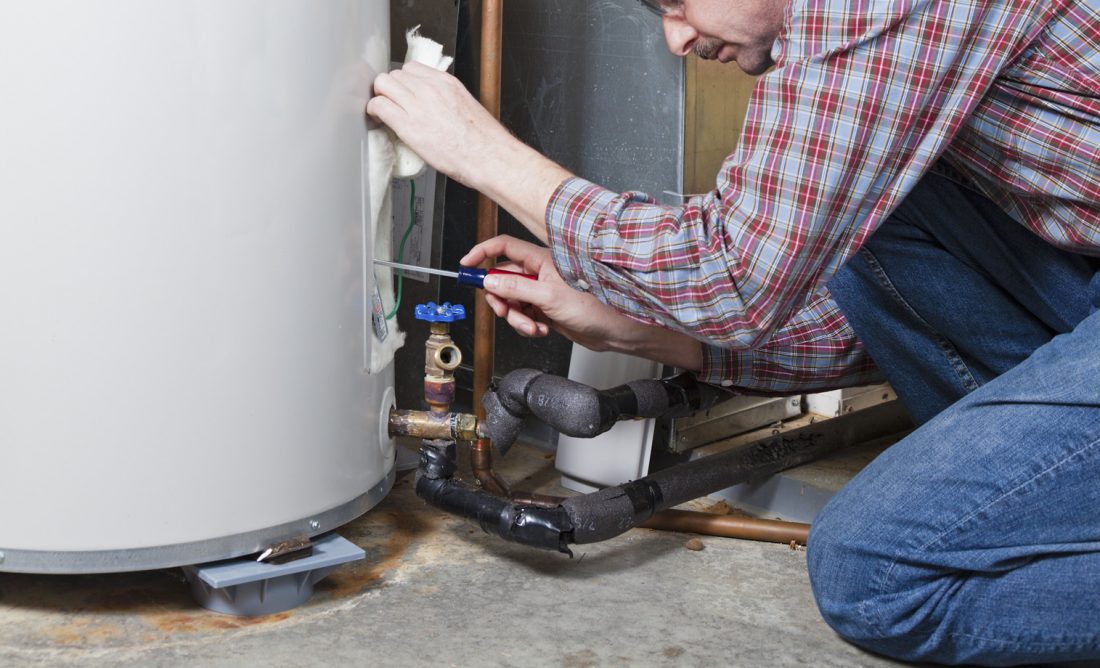
Hot water heaters are among the top 5 causes of home water damage insurance claims. And leaks are common enough that most building codes require the installation of a drain pan underneath. So it makes sense to be aware of the potential hazards and to know what to do about them.
Small Problems, Big Problems
Many different things can go wrong and cause a flooded basement, garage, or laundry room. So it helps to think in terms of “leaks, gushers, and blasts.”
Leaks
A leak may not flood your home or garage, but given time they can cause a surprising amount of damage to wood and drywall. Leaks can occur in several places. The inlet and outlet valves on the top of the water heater are the easiest to see. If they’re covered by insulation, peel it back just a little to check for dampness. The drain valve at the bottom of the tank may also be the problem, as can any of the fittings going to and from the heater. If water collects under the heater with no other clues or there are rust streaks along the side then the tank itself is probably leaking, and the whole heater should be replaced as soon as possible.
Gushers
The temperature and pressure relief valve is usually located on the side of heaters near the top but below the inlets and outlets. Its job is to relieve pressure if the tank overheats and could possibly boil. It too can leak. And if it opens, either in an emergency or due to its failure, it’s like a hose turned on full blast.
Deluge
If the relief valve fails in the closed position, then too much pressure can build up, and the tank can burst, releasing 40 gallons of water (or more) all at once. That’s about half a bathtub full, and enough to fill a 10ten by 10-foot room 1/2 inch deep. Then the cold water pipe continues to deliver some 5 to 15 gallons of water every minute. And an old highly-corroded tank can rupture at normal operating pressures.
What To Do
For anything more than a slow drip, it’s important to take immediate action as it may take several days or weeks for the area to completely dry out. Any lingering moisture quickly leads to mold and other water damage.
Emergency Steps
Shut off the water to end the leak, and then turn off the gas or electricity to protect the heater. Next, open a hot-water faucet to relieve the pressure. If the tank is leaking, connect a hose to the drain valve and drain the tank. Make sure the cold supply is turned off and that a hot-water faucet is open to allow air to come in to replace the water.
Drying
When you experience flooding not just carpet but the sub-floor, cabinet bases, and walls soak up water. That calls for professional water damage restoration experts like Service First. Only the right techniques together with specialized equipment can get everything dry enough before extensive damage set in. That often means ripping up carpet and linoleum, vacuum water extraction, and aggressive structural drying.
If a leak only dampens a small area (a few square feet of drywall or carpet) mopping up and ventilating can be enough to prevent mold and mildew. But don’t risk hidden damage if you’re at all unsure just how deeply dampness goes.
Prevention Tips
According to the Insurance Institute for Business and Home Safety (IBHS), a ruptured tank typically causes $4,000 to $5,000 in water damage. So it pays to take some steps to prevent that or a major leak. Here are a few tips.
- If your water heater is past its warranty period or more than ten years old it’s time to consider a replacement.
- Don’t ignore this appliance. Keep an eye out for leaks, as well as off-color (or smelly) hot water. And an ear out for strange sounds.
- Drain and flush the tank about once a year. And test the relief valve while you’re at it.
- Check where the drain pan drains. Some installations just dump the water from any major leak on to the floor a few feet away!









